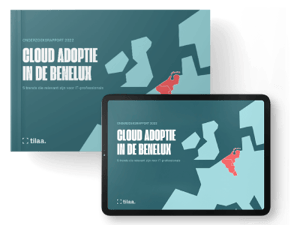
Every decade or two, there’s a technological shift that changes society. In the 60s, the space race. The 80s, CDs and DVDs. The internet in the 90s; social media a decade later; the move to cloud services today. And self-styled “futurists” make endless predictions about these changes and the risks they carry.
What matters here: the futurists are usually wrong.
Today, the hot topic threatening apocalyptic job losses is Artificial Intelligence, or AI. Certainly, any new technology has risks. But at Tilaa, we believe AI will follow the same path as every other revolution. Yes, some old jobs will fade. But the new jobs … the new capabilities … the new opportunities AI will create are much, much greater.
As a European datacentre operator, we keep a keen eye on emerging technologies, with a view to the benefit they’ll bring our clients in the cloud. So in this blog, we’ll see what AI really means for your business – starting with what it really is.
What is AI? Defining Artificial Intelligence
The keyword is artificial. No researchers argue their AIs are “intelligent” in the same way we are. In fact, most AI software work the opposite way to the human brain. Instead of integrating new information into existing schemas of connected concepts – how that lump of grey matter inside your head does it – AI works by differentiating, breaking information down instead of building it up.
OpenAI (the platform AI apps like ChatGPT and Dall-E stand on) is a “Large Language Model”, or LLM. Basically, it breaks down masses of text into “tokens” of just a few characters each, and takes note of the patterns these tokens tend to follow. (For example, “run” is often followed by “away”.)
With source material of 8m documents and 10bn words, it’s built a huge database of patterns. So when you ask it a question, it sees your question as a pattern, and responds with a string of tokens statistically likely to answer it – formatted not as single words or links to sites that hold information on the topic you address, but as humanlike responses, giving you the idea that you’re talking to a human and not a machine.
Ultimately, ChatGPT is just a gigantic version of the predictive text that guesses your words when you send an SMS.
That’s how most AIs work. They are tools, not people. (And SkyNet remains fiction … for now.) But here’s the good news: business today is about making sense of Big Data, often in the cloud. And the approach of AI is great for doing that.
Trends in AI: what’s coming down the road?
So let’s look at some of the things AI is being used for today. Chances are it’s already making your everyday life easier.
Service chatbots. Let’s face it, they used to be awful – and still are, in some places. (Obviously not Tilaa’s!) But if you’ve interacted with a Service Desk recently, it’s likely AI was there – recognising your customer profile, predicting what problem you were likely to have, even lining up a human agent with the most relevant knowledge to solve your pain. In thousands of Service Centres, AI is making support requests smoother, easier, and more useful – if less personal.
Building access and control. The facial recognition on your phone uses AI. As does your identification on camera when you enter a secure office, your thumbprint when you pass through a US airport, even the way your speech flows when you speak. (AI is good at patterns, remember?) AI is helping security get more secure, without taking more time and effort from you.
Predicting and neutralising cyberthreats. The software protecting your business data doesn’t simply react to viruses and phishing attacks as they happen: it looks for suspicious activity (comparing patterns again) and seeks to prevent a bad actor even making an attempt, constantly changing and updating whenever a new type of threat appears. Such methods are incredibly useful in a world gone cloud. Also on the network side, there are AI-based algorithms to detect anomalies in usage and access, or sense unlikely events in the traffic. All with the goal of mitigating possible risks.
Searching and summarising data. Lawyers, doctors, and government officials live their lives smothered in paperwork; information-dense organisations used to spend millions of hours each year simply cataloguing and indexing information. Today, AI can sift and sort even unstructured data like masses of scanned documents or hours of video – saving human researchers huge amounts of time.
Connecting data in dynamic environments. While the pandemic accelerated it, work-from-home and BYOD (Bring Your Own Device) were already trending, as was Shadow IT (people using their own apps in preference to your approved ones). The constant identification, authentication, and authorisation in a large organisation would be a headache for the IT team – so AI’s doing it instead. Keeping people and their data safe and secure, no matter what devices they’re switching between.
That’s how AI is trending today – humdrum tasks involving lots of data, not replacing human professionals. In fact, by automating repetitive and boring tasks, AI is freeing humans to do what they do best: innovate and create.
Artificial Intelligence: plenty of pros – but one big con
That said, it’s not all smooth seas. “Adopting AI” is not a business strategy; making AI do something useful is a business strategy.
So it’s very, very important to work out what you want your AI to do before you decide on a platform or application.
AI won’t help you if it’s not trained on the patterns and processes your business uses. Nor will a friendlier chatbot make a difference if you lack the information and answers to actually solve people’s problems. Remember: it’s a tool, not an employee.
Why choose AI for your organisation?
But you don’t need to be enterprise-scale to make use of AI. With costs falling and results improving all the time, even small and midsized organisations can use AI to reduce costs, streamline operations, and automate common tasks. Best of all, AI is most effective when large datasets are collected together on a single platform, like a cloud. Imagine being a single employee accountancy office that has to process hundreds of annual reports every year – and how much time that would save.
If most of your IT infrastructure is in the cloud, there’s an excellent chance AI can deliver business value. It can analyse a cloud database for useful insights and support management decisionmaking with accurate reports. (Based on data that matters, not just the data that’s on a spreadsheet!) It can respond to your customers 24/7, and triage their requests to direct them to the right place. It can help onboard new employees, demonstrating
the systems and processes their job role needs, and check if the access level is bound to a designated role. And it can show you how your people are using cloud resources, so you can improve procedures and processes to support them.
That’s AI for business. A tool that complements your human skills, not detracts from them.
Conclusion: the tools are here – and the cloud let you use them
AI and the cloud are interlinked. Because large datasets, spread across multiple applications, are where AI can thrive. Think of all the repeated tasks your people do again and again just to get their jobs done – chances are the right AI software can put hours back into their day. The cloud with AI is how you futureproof your business – and you can start today.
Tilaa can help you move your data and applications to the cloud: secure, compliant, and ready to grow with AI – and all in a dazzle-free manner that puts AI to work with your business goals in mind. Contact Tilaa and start making things easier today.


